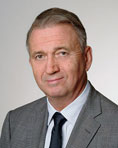
Our times are being moved by mega-trends. These trends are changing our environment and our lives at a faster pace than at any time before in human history.
Consider demographic shifts. The planet is becoming more crowded. In 1900 there were 11 people per square kilometer, now there are 46–and rising fast. By 2050, there will be 62 people per square kilometer.
In 1950, the population of Europe was nearly two-and-a-half times that of Africa’s: by the end of this century, Africa’s population will be more than five times that of Europe’s.
In 1950, the population of Russia was more than two-and-a-half times that of Pakistan’s. By 2050, Pakistan’s population will be more than twice that of Russia’s.
This growing population is disproportionally young: between the ages of 15 and 29. When this generation lacks opportunities, it can become a radical force for change–as we are seeing in North Africa and the Middle East. Or it can become a disillusioned pool of migrants, or the foot soldiers of criminal groups.
Urbanization is exploding: now more than half of the world’s population lives in cities. In 1900, only 16 cities had populations over 1 million, now there are 442.
Demand for food and water is out-stripping supply. Increases in food prices are causing social tensions. In 2008, 61 countries experienced unrest due to food insecurity. One third of the world’s population suffers from water scarcity. This is a humanitarian crisis, and a growing source of conflict.
Natural disasters are becoming more severe and more frequent. And environmental threats are creating instability as well as hardship. Time and space are shrinking, creating a new global marketplace of ideas and identities that transcend national boundaries. Social media, satellite TV, mobile phones, and digital cameras are revolutionizing the speed of communication, and challenging government and media control over how events are portrayed. In 2010 there were more cellphone subscribers than human beings living on our planet in 1985. Globally, access to the internet has doubled in the last 5 years.
This trend also creates new vulnerabilities–like cyber-crime, and the use of the internet by terrorists to recruit, train, and indoctrinate people.
The global economy is shifting. In the past ten years, the so-called BRIC countries have grown from one sixth of the world economy to almost one quarter. Other countries, in the Gulf and Central Asia (like Kazakhstan) are emerging as economic powers. And their political ambitions are rising accordingly. This has brought into existence new clubs, like the G20, and breathed new life into others that used to be insignificant, like the Gulf Cooperation Council.
Recent developments in the Middle East and North Africa put these mega-trends into sharper focus. What is evident is a mismatch between societal expectations and the ability of the political system to deliver.
In the past half century the population of the Arab region has nearly tripled while the population of Europe grew by one third. Much of this growth is in cities. For example, since 1970 the population of Cairo has doubled, while Riyadh’s has grown from 400,000 to 5 million. A disproportional percentage of the Arab population is young and unemployed.
Corruption and a lack of equal opportunities mean that the rich get richer, while the poor get angrier. In the Arab world, economic and technological developments have not everywhere been followed by institutional modernization, causing a lack of faith in political leaders and institutions, as well as in the rule of law.
The implications of the Arab Spring go far beyond North Africa and the Middle East. Many of the conditions and vulnerabilities present in that region exist in other parts of the world. Who’s next? And how is the world going to cope, not only with the spill-over of the crisis, but with the underlying issues that triggered it in the first place?
As a reaction to the trend of globalization, some states are reverting to a very 17th century (Westphalian) view of statehood: retreating behind walls of sovereignty, reasserting their political independence, and resisting external interference.
Multi-lateral institutions are also under stress. The supra-state model of the EU and the global governance of the Bretton Woods system are increasingly regarded as out of sync with reality. Indeed, while most States still adhere to the ideals of the United Nations, institutionally it is increasingly regarded by some as little more than a debating society.
Some states are taking a “do-it-yourself” approach, trying to solve problems on their own. Others are putting their faith in regional actors. Or states look to the G20 or the G8, and are even pondering new such clubs.
The heated debates within the UN, NATO and elsewhere about what to do in North Africa are a good illustration of tensions with the international system–raising issues about sovereignty, external interference, humanitarian intervention, and the responsibility to protect. Multilateral organizations, including the Organization of the Islamic Conference, need to come to grips with the fact that the mega-trends that we are witnessing are fast-rising and long-term. Increasingly, we will be forced to cope with crisis, conflict, and change on a scale and at a speed that we have not faced in the past.
It is therefore time to overhaul the international system. This must be done through an in-depth and candid debate about the purpose and architecture of the future multi-lateral system.
There are no off-the-rack solutions. I think we have to go about it like a skillful tailor: designing clothes for a completely new body.
This article is reproduced from The Astana Times.







